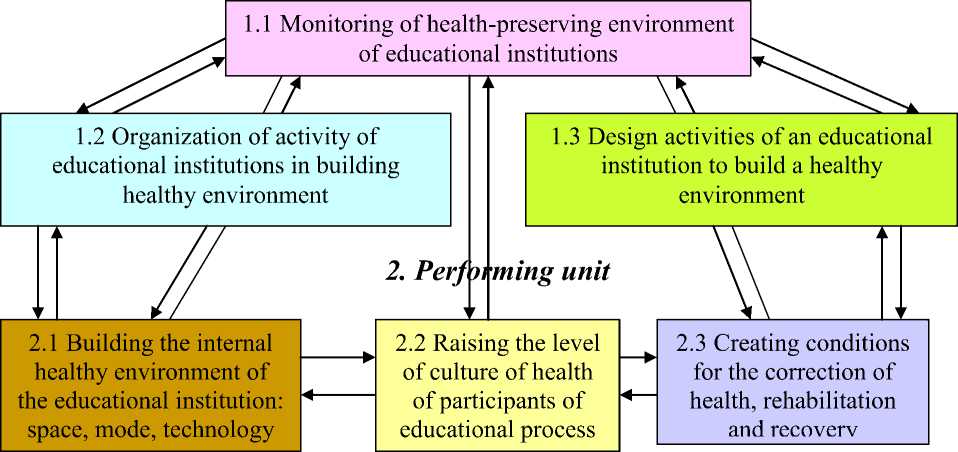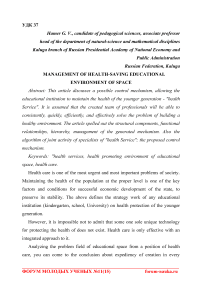Management of health-saving educational environment of space
Бесплатный доступ
This article discusses a possible control mechanism, allowing the educational institution to maintain the health of the younger generation - "health Service". It is assumed that the created team of professionals will be able to consistently, quickly, efficiently, and effectively solve the problem of building a healthy environment. The article spelled out the structural components, functional relationships, hierarchy, management of the generated mechanism. Also the algorithm of joint activity of specialists of "health Service"; the proposed control mechanism.
"health services, health promoting environment of educational space, health care
Короткий адрес: https://sciup.org/140277279
IDR: 140277279
Текст научной статьи Management of health-saving educational environment of space
Health care is one of the most urgent and most important problems of society. Maintaining the health of the population at the proper level is one of the key factors and conditions for successful economic development of the state, to preserve its stability. The above defines the strategy work of any educational institution (kindergarten, school, University) on health protection of the younger generation.
However, it is impossible not to admit that some one sole unique technology for protecting the health of does not exist. Health care is only effective with an integrated approach to it.
Analyzing the problem field of educational space from a position of health care, you can come to the conclusion about expediency of creation in every educational institution the "health Service" - a team of professionals capable of consistently, quickly, effectively, and efficiently to solve the problem of building a healthy environment [1].
The purpose of the study is to develop a model of the structural division "health Service" to manage the health care environment of the educational institution.
Objectives of the study: to identify structural components "health Service", their functional relationship and hierarchy management; to develop an algorithm of joint activity of specialists of "health Service"; to propose a management mechanism.
A design decision. It is assumed that the "health Service" is designed to perform the following functions: the construction of the internal environment of educational institutions that provide health saving nature of the educational process and the safety of children, pupils, students and their teachers; improving the culture of health as a component of General culture of the younger generation, teachers, parents and the formation on the basis of its willingness to preserve and strengthen your health and the health of others; creation of conditions for recovery; systematization and organization of activity of educational institutions to build a health-preserving educational environment.
We describe models of individual graduate institutions of preschool education, school and higher education (table 1).
Table 1. The model of the graduate student educational institutions
|
preschool |
school |
higher |
|
V knowledge of the basics of personal hygiene, the implementation of the rules of hygiene; V basic knowledge of personal hygiene, a healthy lifestyle. |
V a basic knowledge of the structure and functioning of the human body;
|
|
The expected result of the "health Service" is represented by the following indicators (table 2).
Table 2. Indicators measuring the activities of "health Service"
|
Quantitative indicators |
Qualitative indicators |
development and physical preparedness. |
lifestyle;
commitment of teachers in safeguarding health. |
System work, "health Service" starts with a preliminary analysis of healthsaving potential of educational institutions on the basis of monitoring.
The first (summative) slice monitoring provides an opportunity to identify actual problems of educational institutions and to determine priorities to build a healthy environment. At the same time solved the organizational problem associated with the selection of personnel and coordination of activities of specialists "health Service" on the main directions of work.
The team of "health Service" projects the activity of an educational institution to build a health-preserving educational environment, develops its program, and ensures General training of the teaching staff and social partners to its implementation.
The scheme (Fig. 1) shows the algorithm of the activities of "health Service", proceeding from conditions of specific educational institutions.
The following diagnostic cut monitoring enables to identify the performance of health care activity in comparison with the previous year.
The specialists of "health Service" annual monitoring of the health status, physical and mental development of the child, teenager, student. Results will be recorded in the health Passport, which can be an integral part of the Portfolio.
1. The control unit

Figure 1. Algorithm of activities of the "health Service"
The presented project was developed 11 head teachers of schools of the Smolensk region, which passed training in the framework of the Presidential program "management Training in the field of health, education and culture" in Kaluga branch of Ranepa. In 9 schools of the region created by the teachers "health Service" function for the third year. Most importantly, what has been done during this period, as noted by the teachers, to change the attitude of pupils, their parents to their health, exercising, maintaining a healthy lifestyle.
With 2011 in the Kaluga branch of the Ranepa Presidential programme. Over 1,500 Directors, Deputy Directors of educational institutions, health care institutions, of culture of Kaluga, Bryansk, Smolensk regions have been trained, prepared and implemented projects on topical issues in their field of work [2-14].
Sources used:
-
1. Организация Службы здоровья в образовательных учреждениях Санкт-Петербурга: Учебно-методическое пособие / Служба здоровья образовательного учреждения: от замысла до реализации: Учебнометодический комплект/ Под ред. М.Г. Колесниковой. Вып. 4. – СПб.: СПбАППО, 2006. – 102 с.
-
2. Анохина Л.В. Управление рисками при реализации реальных инвестиционных проектов // WORLD SCIENCE: PROBLEMS AND INNOVATIONS сборник статей победителей IX Международной научнопрактической конференции: в 2 частях. 2017. С.58-60.
-
3. Анохина С.А., Мезенцева А.С. Математика и экономика – взаимосвязь наук // European Scientific Conference сборник статей V Международной научно-практической конференции: в 3 частях. 2017. С. 14-16.
-
4. Градская С.С., Анохина Л.В. Организационно-методологическое обоснование автокредитования с отсрочкой погашения «БАЙБЭК» // Вестник Калужского филиала РАНХиГС. Калуга, 2015. С. 54-60.
-
5. Емельянова Е.В. «Зеленый» туризм / Морозова А.А., Емельянова Е.В. // Вестник Калужского филиала РАНХиГС. Калуга, 2015. С. 141-143.
-
6. Зарапина А.О., Озерова Е.И. Кластерный анализ дебиторской задолженности в обеспечении экономической безопасности организации // Государство и бизнес. Современные проблемы экономики Материалы VII Международной научно-практической конференции. Северо-Западный институт управления РАНХиГС при Президенте РФ, Факультет экономики и финансов. 2015. С. 175-176.
-
7. Корнеева Р.В. Методы и перспективы развития использования СПС КонсультантПлюс в учебном процессе // Новые технологии в образовании Сборник статей III Международной научно-практической конференции. ООО «Научно-инновационный центр». 2015. С.230-233.
-
8. Мезенцева А.С. Высшая математика для студентов экономических специальностей // Инновационные технологии в образовании и науке Сборник материалов Международной научно-практической конференции. В 2-х томах. Редколлегия: О.Н. Широков [и др.]. 2017. С.126-127.
-
9. Смирнова А.С., Емельянова Е.В. Совершенствование кадровой политики в ООО «Ашан» // Вестник Калужского филиала РАНХиГС. Калуга, 2015. С. 170-174.
-
10. Унгуряну П.О., Емельянова Е.В. Организация промоакций в GROUPE AUSHAN SA // Вестник Калужского филиала РАНХиГС. Калуга, 2015. С. 180-183.
-
11. Хамер Г.В., Абрамова Т. Перспективы импортозамещения в Калужской области // Экономика и бизнес: теория и практика. 2017. №4-2. С. 113-119.
-
12. Хамер Г.В., Щадова М.М. Статистический анализ инвестиций стран – членов Европейского союза в экономику России // Форум молодых ученых. 2017. №5 (9). С. 2201-2204.
-
13. Хамер Г.В. Сайт и квест «Интерактивное путешествие по местам боевой славы Калуги» как средства воспитания патриотизма подрастающего поколения / Асеев П.С., Хамер Г.В. // Вестник Калужского филиала РАНХиГС. Калуга, 2015. С. 6-8.
-
14. Чернышенко Н.С., Анохина Л.В. Финансовый менеджмент организации: перспективные направления совершенствования // Вестник Калужского филиала РАНХиГС. Калуга, 2015. С. 187-190.
Список литературы Management of health-saving educational environment of space
- Организация Службы здоровья в образовательных учреждениях Санкт-Петербурга: Учебно-методическое пособие / Служба здоровья образовательного учреждения: от замысла до реализации: Учебно-методический комплект/ Под ред. М.Г. Колесниковой. Вып. 4. - СПб.: СПбАППО, 2006. - 102 с.
- Анохина Л.В. Управление рисками при реализации реальных инвестиционных проектов // WORLD SCIENCE: PROBLEMS AND INNOVATIONS сборник статей победителей IX Международной научно-практической конференции: в 2 частях. 2017. С.58-60.
- Анохина С.А., Мезенцева А.С. Математика и экономика - взаимосвязь наук // European Scientific Conference сборник статей V Международной научно-практической конференции: в 3 частях. 2017. С. 14-16.
- Градская С.С., Анохина Л.В. Организационно-методологическое обоснование автокредитования с отсрочкой погашения «БАЙБЭК» // Вестник Калужского филиала РАНХиГС. Калуга, 2015. С. 54-60.
- Емельянова Е.В. «Зеленый» туризм / Морозова А.А., Емельянова Е.В. // Вестник Калужского филиала РАНХиГС. Калуга, 2015. С. 141-143.
- Зарапина А.О., Озерова Е.И. Кластерный анализ дебиторской задолженности в обеспечении экономической безопасности организации // Государство и бизнес. Современные проблемы экономики Материалы VII Международной научно-практической конференции. Северо-Западный институт управления РАНХиГС при Президенте РФ, Факультет экономики и финансов. 2015. С. 175-176.
- Корнеева Р.В. Методы и перспективы развития использования СПС КонсультантПлюс в учебном процессе // Новые технологии в образовании Сборник статей III Международной научно-практической конференции. ООО «Научно-инновационный центр». 2015. С.230-233.
- Мезенцева А.С. Высшая математика для студентов экономических специальностей // Инновационные технологии в образовании и науке Сборник материалов Международной научно-практической конференции. В 2-х томах. Редколлегия: О.Н. Широков [и др.]. 2017. С.126-127.
- Смирнова А.С., Емельянова Е.В. Совершенствование кадровой политики в ООО «Ашан» // Вестник Калужского филиала РАНХиГС. Калуга, 2015. С. 170-174.
- Унгуряну П.О., Емельянова Е.В. Организация промоакций в GROUPE AUSHAN SA // Вестник Калужского филиала РАНХиГС. Калуга, 2015. С. 180-183.
- Хамер Г.В., Абрамова Т. Перспективы импортозамещения в Калужской области // Экономика и бизнес: теория и практика. 2017. №4-2. С. 113-119.
- Хамер Г.В., Щадова М.М. Статистический анализ инвестиций стран - членов Европейского союза в экономику России // Форум молодых ученых. 2017. №5 (9). С. 2201-2204.
- Хамер Г.В. Сайт и квест «Интерактивное путешествие по местам боевой славы Калуги» как средства воспитания патриотизма подрастающего поколения / Асеев П.С., Хамер Г.В. // Вестник Калужского филиала РАНХиГС. Калуга, 2015. С. 6-8.
- Чернышенко Н.С., Анохина Л.В. Финансовый менеджмент организации: перспективные направления совершенствования // Вестник Калужского филиала РАНХиГС. Калуга, 2015. С. 187-190.


